SDU has a proud tradition of receiving PRACE grants. Since the first Call in 2010, 36 proposals for project access with affiliation to Danish universities have been awarded compute time through PRACE for a total of more than 1,000,000,000 core*hours. SDU was involved in 11 of them for a total of ~30 % of the total resources awarded to Danish researchers.
PRACE (Partnership for Advanced Computing in Europe) gives researchers from the 26 member countries, including Denmark, access to 8 of the largest supercomputers in Europe. The resources are awarded through a peer review process where the scientific qualities and the demonstration of technical capabilities are evaluated.
Currently, three SDU researchers are involved in PRACE projects.
“From the technical standpoint, we aim to deliver a MC simulation algorithm to investigate membrane deformations near free membrane edges and pores,” says Himanshu Khandelia, Associate Professor at Department of Physics, Chemistry and Pharmacy at SDU and Project Leader of MEMREP: Multi-scale simulations of annexin-mediated membrane repair mechanisms and of strategies to undermine membrane repair in cancer cells.

Himanshu Khandelia’s project was awarded 56,700,000 core*hours on Marconi100 hosted by CINECA in Italy under Call 21. It could potentially lead to new anticancer approaches.
“The key outcome will be a molecular mechanism describing the nature and significance of the membrane deformations induced by Annexin proteins in membrane repair processes,” says Himanshu Khandelia. “The second outcome is a strategy to interfere with the repair mechanism in cancer cells using phenothiazine drugs.”
Another project affiliated with SDU, which currently uses compute time granted by PRACE, is Breaking the Strong Interaction: Towards Quantitative Understanding of the Quark-Gluon Plasma. Assistant Professor at Department of Mathematics and Computer Science, Benjamin Jäger, is a collaborator on this project, which is lead by Prof. Chris Allton from Swansea University.
“The strong force is one of the four fundamental forces in nature, and as the name suggests, the strongest of all four interactions. Quantum ChromoDynamics (QCD) is the quantum field theory of the strong force, which explains the formation of matter in the universe. The lattice formulation is the only non-perturbative formulation of QCD, which enables direct numerical simulation. Even though the strong force has been studied for decades, surprisingly very little is known about the behavior of the strong force when exposed to very large temperatures and densities,” says Benjamin Jäger about the project.
Breaking the Strong Interaction: Towards Quantitative Understanding of the Quark-Gluon Plasma is a multi-year project and has been awarded:
- 30,000,000 core*hours on MARCONI (KNL) hosted by CINECA in Italy under Call 18.
- 20,000,000 core*hours on Joliot-Curie Rome hosted by GENCI at CEA in France under Call 20.
- 35,000,000 core*hours on Hawk hosted by GCS at HLRS in Germany under Call 22.
According to Benjamin Jäger, a 3-year PRACE grant is advantageous as you can rely on computing resources for an extended period of time. It also enables you to do even more ambitious projects, which require more time and HPC:
“HPC is essential for our project as it involves large scale lattice simulations. Typical lattice simulations can easily need 1000 compute cores. So, having access to a European Tier-0 machine enables us to do state-of-the-art simulations.”
The third SDU project, which currently uses compute time granted by PRACE, is Polymer physics, lead by Carsten Svaneborg, Associate Professor at Department of Physics, Chemistry and Pharmacy at SDU. Under Call 22, this project was awarded 43,000,000 core*hours on Joliot-Curie (SKL) hosted by GENCI at CEA in France.
The advantages of a European HPC grant
Instead of having small supercomputers locally, PRACE makes it possible to share resources among different researchers, institutions and countries. According to Benjamin Jäger, this enables researchers to get more computing resources for the amount of money spend. On top of this, the application to PRACE is straightforward:
“Besides your scientific reason, you also need to show that you need Tier-0 resources and are able to utilize such big machines efficiently.”
In the future, PRACE will handle applications for EuroHPC, and applying for a PRACE grant can therefore be a good way to get a head start on how to apply for the international resources, which will soon become available through DeiC. For SDU, it is certainly a plus that so many of our researchers already know the application process in PRACE well and therefore are well prepared for how they acquire international HPC resources in the future.
If you want to know more about how to apply for resources through PRACE, you can contact the SDU Front Office:
https://escience.sdu.dk/index.php/sdu-front-office/
Other PRACE projects at SDU
Below you will find a list of other projects with affiliation to SDU, which have been awarded compute time through PRACE:
- Prof. Claudio Pica (Project Leader), Strong interactions beyond QCD, awarded 22,133,333 core*hours on FERMI hosted by CINECA in Italy under Call 4.
- Dr. Ari Hietanen (Project Leader), Simulating Dark Matter on the Lattice awarded 7,300,000 core*hours on MareNostrum 3 hosted by BSC in Spain under Call 6.
- Dr. Vincent Drach (collaborator), Nucleon structure using lattice QCD simulations with physical pion mass awarded 65,000 core*hours on Curie (hybrid nodes) hosted by GENCI at CEA in France, 13,800,000 core*hours on SuperMUC hosted by GCS at LRZ in Germany, 25,300,000 core*hours on FERMI hosted by CINECA in Italy under Call 9.
- Prof. Claudio Pica (Project Leader), MCH – Minimal Composite Higgs awarded 7,500,000 core*hours on MareNostrum 3 hosted by BSC in Spain under Call 9.
- Dr. Himanshu Khandelia (Project Leader), FLEXO: The relationship between electrostatic potential and curvature in biomembranes, and its impact on membrane transport awarded 18,000,000 core*hours on Piz Daint hosted by CSCS in Switzerland under Call 14.
- Prof. John Bulava (Project Leader), Lattice QCD master field simulations at physical quark masses awarded 60,000,000 core*hours on SuperMUC hosted by GCS at LRZ in Germany under Call 20.
By Johanne Lyhne Hansen


